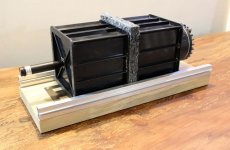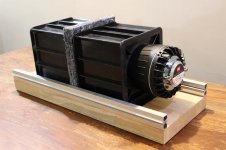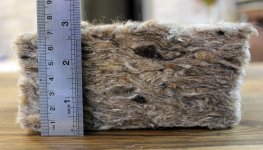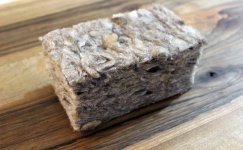In the 8C the midwoofer is cardioid operating between 100Hz and about 1.2K right in the range where it is most beneficial. Getting a good match in directivity at either end is where all the experimenting is needed.Are you using this speaker in a house? If so, cardioid doesn't help you below 150Hz because you're below the room transition.
Delay only helps on one axis. At 90 degrees the delay is gone and at 180 degrees it has turned the other way.
What radiator type and mechanical construction you are talking about? Effect of delay in 3D space depends on acoustical concept. It can't be generalized.
...where it is most beneficial.
I prefer cardioidish down to 20 Hz. It can be beneficial without being the most beneficial.
I used 95kg/m3 felt in different volumes with no luck at all. it seems a very hard job to be done.
without the ability to measure both sides' responses individually, it would be impossible to be done. I need a big baffle to mound the speaker with the resistive box on it so I can measure responses on both sides of the baffle and then try to match them.
Last edited:
Earl Geddes makes a good argument in terms of the value of monopole vs cardioid vs dipole in this thread on cardioid bass.
He also discusses the question in his Geddes Design Philosophy document and it boils down to the fact the room dominates the source type, therefore, don't waste energy with lossy designs based on destructive interference. (in small rooms at low frequencies)
In a small room, i.e. not an auditorium, there is very little to be gained from a directional bass source. SO basically all of the configurations that you showed are simply ways to expend more money with no net gain.
In a large venue there is some reason for directional bass, but the configurations that you show above would not work very well. 1) is not going to work because the delay of the front from the rear is not great enough to do anything - it will be a dipole. 2) will have trouble because the outputs of the two sources won't track each other (monpole versus dipole) and so without some complex EQ this won't work very well. 3) may work to some extent, but again probably not very well without some signal processing.
The best is a forward facing driver or two and a rear facing one like 3) above, but with some signal processing control on the rear facing driver. This can be made to work quite well and has been sold by JBL in the past.
He also discusses the question in his Geddes Design Philosophy document and it boils down to the fact the room dominates the source type, therefore, don't waste energy with lossy designs based on destructive interference. (in small rooms at low frequencies)
"One thing is certain from this discussion; without some means of dealing with the low frequency modes in a small room, no speaker will sound optimum at these frequencies. You will hear the room, not the speakers. The source characteristics at these low frequencies is not a critical issue since the room virtually always dominates the situation. The important factor is the sources ability to produce sufficient energy at lower and lower frequencies. This places a substantial burden on the low frequency driver, especially at high Sound Pressure Levels (SPL) like those required in a Home Theater." - The Geddes Loudspeaker System Design Philosophy, page 3.
In the 8C the midwoofer is cardioid operating between 100Hz and about 1.2K right in the range where it is most beneficial. Getting a good match in directivity at either end is where all the experimenting is needed.
I don't understand what you mean by matching directivity at 100Hz.
Earl Geddes makes a good argument in terms of the value of monopole vs cardioid vs dipole in this thread on cardioid bass.
You quoted just comments about image including three different ways to try kinda cardioid sub. Those are maybe the worst three, providing zero information is cardioid bass valuable and why it could be probable winner in many...most of the cases assuming that we're talking about main speakers (not separate sub channel enabling almost any number of radiators).
According to this calculator, a fibrous material with a density of 40kg/m3 will reduce the speed of sound to 58meters per second. (it's a little bit odd to me). I have to verify it by actual measurement so I will know how much delay will occur for a given thickness of that certain material.
I hope this transmission loss measurement chamber will help me to measure the effect of different materials on the speed of sound tough the frequency range is not that low with BMS 4592ND. I'm gonna use Holmimpulse and see what happens in the time domain. I may build a new plane wave tube with low frequency driver if needed.
I hope this transmission loss measurement chamber will help me to measure the effect of different materials on the speed of sound tough the frequency range is not that low with BMS 4592ND. I'm gonna use Holmimpulse and see what happens in the time domain. I may build a new plane wave tube with low frequency driver if needed.
Attachments
Last edited:
A resistive cardioid tends to work over a limited frequency band so the trick in a speaker like this is to set it up to give the directivity that is wanted and still blend smoothly with the upper and lower drivers. If the monopole woofers were used at 100Hz like in the 8C then having the cardioid lose all directivity by that point or above would create a good match.I don't understand what you mean by matching directivity at 100Hz.
You quoted just comments about image including three different ways to try kinda cardioid sub. Those are maybe the worst three, providing zero information is cardioid bass valuable and why it could be probable winner in many...most of the cases assuming that we're talking about main speakers (not separate sub channel enabling almost any number of radiators).
You're right, I meant to say, "in this thread". I forgot to include that phrase. That was his first comment in a thread specifically on Cardioid Bass. His comments throughout the thread explain why cardioid below room transition isn't valuable.
He makes the common arguments about modal room behavior in addition to how humans perceive low frequencies.
john k... quoted a paper by Juha Backman that researched low frequency polar patterns here. His quote is longer than what I copied here so you can read the full post for a more complete quote from the paper (or the paper itself AES Convention Papers Forum >> Low-frequency Polar Pattern Control for Improved In-room Response)
“As a summary of the results presented above for the room-speaker interaction it can be stated that cardioid source has more immunity against changes in source placement or room absorption in sparsely modal range. Below the lowest mode the cardioid speaker does not have any advantage over the monopole source, but both exhibit higher output and less source position dependence than the dipole speaker. These results indicate that creating a loudspeaker that has a unidirectional polar pattern [cardioid] in the sparsely modal region and omnidirectional below the lowest mode represents a good compromise between low frequency output capability and
avoiding room coloration effects. ”
From:
1) Low-frequency polar pattern control for improved in-room response. Juha Backman, Presented at the 115th Convention 2003
October 10–13
Backman's paper is from 2003 so maybe there is new research available.
His comments throughout the thread explain why cardioid below room transition isn't valuable.
All that was based on assumptions about shape, size and rigidity of the room/building. Those assumptions may match with reality in some cases, but also in those cases cardioid bass supports the most typical speaker locations better than the other source types.
Unfortunately he has ruled discussion so hardly and long time that really open discussion about advantages in practice and reasons has not been and will not be possible before the next generation.
so you can read the full post for a more complete quote from the paper
I've had that paper over a decade and built speakers with cardioid bass since 2004 so figure it out why I don't agree with anybody claiming that it's not valuable.
Interesting.All that was based on assumptions about shape, size and rigidity of the room/building. Those assumptions may match with reality in some cases, but also in those cases cardioid bass supports the most typical speaker locations better than the other source types.
Unfortunately he has ruled discussion so hardly and long time that really open discussion about advantages in practice and reasons has not been and will not be possible before the next generation.
It was a bit hard to follow discussion of cardioid benefit. In post #47 bradleypnw referred to this thread https://www.diyaudio.com/forums/multi-way/121590-cardioid-bass.html#post1488480 where Geddes and Kreskowsky argued about the benefits of cardioid bass. Backman's paper was referred and he concluded that cardioid doesn't give benefit below lowest mode.
Bradleypnw changed that to below transition, which is a major misconcept. Lowest mode is typically around 30-45Hx and Schroeder transition is 300-600Hz
D&D 8c is cardioid from 100Hz, which is determined mostly by form factor ie. size of the cabinet and woofer's Sd x excursion capacity. If we took a look at kimmosto's cardioids we noticed they use 2x15" woofers to reach that 20Hz with dsp. Now it looks like Kimmo has cleaned his homepage of speaker projects, but fortunately we have many other old cardioid threads here at diyaudio!
Bradleypnw changed that to below transition, which is a major misconcept. Lowest mode is typically around 30-45Hx and Schroeder transition is 300-600Hz
D&D 8c is cardioid from 100Hz, which is determined mostly by form factor ie. size of the cabinet and woofer's Sd x excursion capacity. If we took a look at kimmosto's cardioids we noticed they use 2x15" woofers to reach that 20Hz with dsp. Now it looks like Kimmo has cleaned his homepage of speaker projects, but fortunately we have many other old cardioid threads here at diyaudio!
Last edited:
^Good points (BTW my design were 12" and 18").
Both the lowest mode and transition frequency are quite obscure in practice. Many (maybe the most) of listening environments do not have clear lowest mode due to large total volume, leaks, openings, complexity and diffusion. Transition f is even more obscure. Open concept living spaces are popular so maybe the most relevant thing is how speakers perform in possible locations in your room - where speakers are not in the middle of walking routes or door openings. Good performance usually requires something else than location on the front wall or corners, for example front baffle 80...120 cm from front wall so mixed source has very good changes. That is challenging...impossible placement for monopoles when rear side of the room is acoustically large. Not so tough for dipoles anymore though optimal gap could be e.g. 120...130 cm. Listening point is easier to optimize - and that is certainly needed and valuable with all source types.
Argument about the lowest mode is also questionable/just weighting because room gain is low with mixed sources (see Backman's paper). This means that you can create main speakers which do not necessarily require LF level or EQ adjustment in different rooms and locations from free field to concrete flat <20m2. This is important if listener does not like or want to use any room EQ due to other electronics. Of course mixed source is trade-off between flexibility and SPL capacity. That can be compensated with larger woofers and location of side ports/drivers, though monopole wins that game by default.
So arguments against cardioidish based on simplified theories including assumptions that the lowest mode and transition frequency are always there are as single-minded, pessimistic and mentally braking as any other arguments based on some generalizations.
Both the lowest mode and transition frequency are quite obscure in practice. Many (maybe the most) of listening environments do not have clear lowest mode due to large total volume, leaks, openings, complexity and diffusion. Transition f is even more obscure. Open concept living spaces are popular so maybe the most relevant thing is how speakers perform in possible locations in your room - where speakers are not in the middle of walking routes or door openings. Good performance usually requires something else than location on the front wall or corners, for example front baffle 80...120 cm from front wall so mixed source has very good changes. That is challenging...impossible placement for monopoles when rear side of the room is acoustically large. Not so tough for dipoles anymore though optimal gap could be e.g. 120...130 cm. Listening point is easier to optimize - and that is certainly needed and valuable with all source types.
Argument about the lowest mode is also questionable/just weighting because room gain is low with mixed sources (see Backman's paper). This means that you can create main speakers which do not necessarily require LF level or EQ adjustment in different rooms and locations from free field to concrete flat <20m2. This is important if listener does not like or want to use any room EQ due to other electronics. Of course mixed source is trade-off between flexibility and SPL capacity. That can be compensated with larger woofers and location of side ports/drivers, though monopole wins that game by default.
So arguments against cardioidish based on simplified theories including assumptions that the lowest mode and transition frequency are always there are as single-minded, pessimistic and mentally braking as any other arguments based on some generalizations.
the company I work for (Loudspeaker and acoustic panels manufacturer) produces some nice natural sheep wool insulation felt. it's totally odorless and natural contrary to fiberglass which is made of slag/waste of steel refinery furnace which contains unwanted elements, something active elements. it's the best thing we have ever used for speakers' internal dampening.
I may try this natural wool felt as well but I think it lacks the consistency/uniformity:
I may try this natural wool felt as well but I think it lacks the consistency/uniformity:
Attachments
Unfortunately he has ruled discussion so hardly and long time that really open discussion about advantages in practice and reasons has not been and will not be possible before the next generation.
Yes, interesting point of view. However, I think a good discussion is possible now. There are three expert researchers who get quoted on here a lot: Linkwitz, Toole, and Geddes. Of course they agree on many things, but if you look at the kind of speaker system they designed (or in the case of Floyd, chose to own) they are quite different. So clearly there are valid differences in opinion even among the most knowledgeable. It would be interesting to know what speaker systems D.B. Keele and Kevin Voecks use for their personal enjoyment.
So, yes, there will always be devoted followers of every design philosophy, but we can not let them drown out a good open discussion.
j.
The worst problem IMO is that with these different designs you are always hearing arguments based on their interaction with rooms, NOT about any other factors that might lead to preference.
- Home
- Loudspeakers
- Multi-Way
- Resistive port cardioid active speaker insipired by D&D 8C



